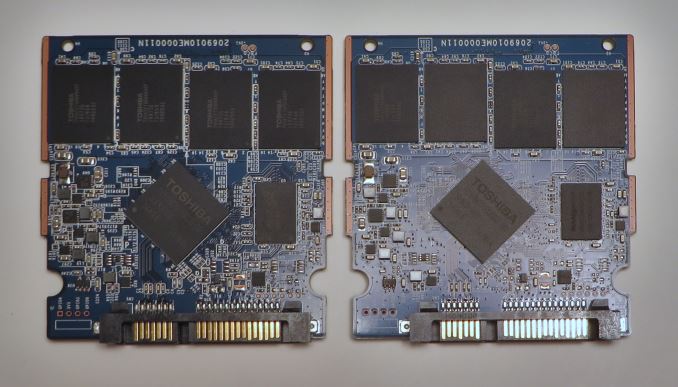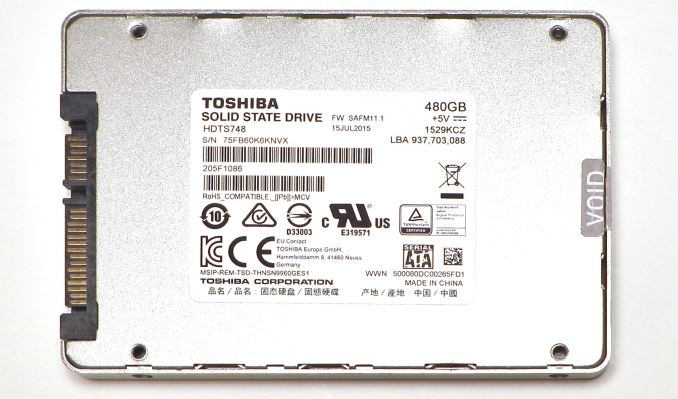
Original Link: https://www.anandtech.com/show/10084/the-toshiba-q300-ssd-review
The Toshiba Q300 SSD Review: Toshiba Becomes a Retail Brand
by Billy Tallis on February 26, 2016 8:00 AM EST
Our review of the OCZ Trion 100 hailed it as "Bringing Toshiba to the Retail". The Trion 100 was branded as an OCZ drive, but it was almost entirely developed and manufactured by parent company Toshiba as their first non-OEM SSD. A few months later, Toshiba entered the retail SSD market under their own brand with the Q300 and Q300 Pro SSDs. The Q300 is based on the same hardware platform as the Trion 100 and is the entry-level model in Toshiba's retail SSD line.
For long-time followers of the SSD market, OCZ's brand may still be associated with controversy and the factors that contributed to their bankruptcy and eventual acquisition by Toshiba. In the broader consumer market OCZ is relatively unknown. By contrast, Toshiba is a massive conglomerate that has been a household name for decades. Drives like the Q300 are intended to expand the SSD market at the low end and are marketed as alternatives to hard drives rather than replacements for previous SSDs. In that light, it appears that Toshiba's strategy may have been to use the Trion 100's earlier release to make sure everything was working properly before releasing the Q300 to catch the eye of a wider audience.
| Toshiba Q300 SATA SSDs | ||||
| Capacity | 960GB | 480GB | 240GB | 120GB |
| NAND | Toshiba A19nm 128Gb TLC | |||
| Controller | Toshiba TC58 | |||
| Sequential Read | 550 MB/s | |||
| Sequential Write | 530 MB/s | |||
| 4kB Random Read IOPS | 87k | |||
| 4kB Random Write IOPS | 83k | |||
| Endurance Rating | 240TB | 120TB | 60TB | 30TB |
| Active Power Consumption | 5.1W | |||
| Idle Power Consumption | 1.1W | |||
| Warranty | 3 years | |||
Both the OCZ Trion 100 and the Toshiba Q300 are based around the Toshiba TC58NC1000 controller, Toshiba's custom edition of the Phison S10 controller. Toshiba already manufactures Phison's drives that are sold to many other brands, so selling some under their own brands was a small step. The Trion 100 and Q300 use the same PCB, one that is extremely similar to other Phison drives we have encountered but with some minor differences in component selection. The hardware of the Trion 100 and Q300 differs only in the selection of DRAM: The Trion uses Nanya DRAM where the Q300 has a Micron DRAM chip. Both drives sport the same Toshiba A19nm 128Gb TLC NAND flash in four packages with up to 16 die per package for the 960GB versions.
Left: Toshiba Q300.Right: OCZ Trion 100
As SSDs with TLC flash are primarily geared towards the entry level market, they are developed with a focus on price and capacity balanced against more modest performance. Aside from Samsung's 850 EVO, the current crop of TLC drives are all low-end drives judging by their performance - with the similar Trion 100 among the slowest - and the market is in a race to the bottom trying to offer the lowest cost per gigabyte. However with that said, even our current slowest SSD (the Crucial BX200) is significantly faster than a hard drive. As low-end SSDs close in on hard drive prices, they are making the higher performance and lower latency of SSDs available to a wider range of computers. The Q300's initial MSRP and its current price direct from Toshiba make it clear they're somewhat in denial about its status as a low-end drive, but prices at other retailers are only slightly higher than the Trion 100.
| AnandTech 2015 SSD Test System | |
| CPU | Intel Core i7-4770K running at 3.5GHz (Turbo & EIST enabled, C-states disabled) |
| Motherboard | ASUS Z97 Deluxe (BIOS 2501) |
| Chipset | Intel Z97 |
| Memory | Corsair Vengeance DDR3-1866 2x8GB (9-10-9-27 2T) |
| Graphics | Intel HD Graphics 4600 |
| Desktop Resolution | 1920 x 1200 |
| OS | Windows 8.1 x64 |
- Thanks to Intel for the Core i7-4770K CPU
- Thanks to ASUS for the Z97 Deluxe motherboard
- Thanks to Corsair for the Vengeance 16GB DDR3-1866 DRAM kit, RM750 power supply, Carbide 200R case, and Hydro H60 CPU cooler
Performance Consistency
Before we start things off, I would like to cover a quick housekeeping note. Over the winter I've made some changes to the SSD testbed and our benchmarking procedures, with the goal of streamlining the process as much as possible while still producing results that are directly comparable with our 2015 benchmark scores. Performance testing is conducted with drives in a hot-swap bay so that they can be pulled from the testbed to be securely erased and pre-filled by a separate computer. I still have to manually move the drives around between phases of our benchmark suite, but the entire process of running the tests and parsing the results to generate graphs for the review is now automated and much less error prone. The new process also keeps more of the raw data around, so in future reviews I may experiment with new ways to graph what we're measuring. The Toshiba Q300's close similarity to the OCZ Trion 100 has helped validate the new procedures.
With that out of the way, we start things off with our performance consistency test, which explores the extent to which a drive can reliably sustain performance during a long-duration random write test. Specifications for consumer drives typically list peak performance numbers only attainable in ideal conditions. The performance in a worst-case scenario can be drastically different as over the course of a long test drives can run out of spare area, have to start performing garbage collection, and sometimes even reach power or thermal limits.
In addition to an overall decline in performance, a long test can show patterns in how performance varies on shorter timescales. Some drives will exhibit very little variance in performance from second to second, while others will show massive drops in performance during each garbage collection cycle but otherwise maintain good performance, and others show constantly wide variance. If a drive periodically slows to hard drive levels of performance, it may feel slow to use even if its overall average performance is very high.
To maximally stress the drive's controller and force it to perform garbage collection and wear leveling, this test conducts 4kB random writes with a queue depth of 32. The drive is filled before the start of the test, and the test duration is one hour. Any spare area will be exhausted early in the test and by the end of the hour even the largest drives with the most overprovisioning will have reached a steady state. We use the last 400 seconds of the test to score the drive both on steady-state average writes per second and on its performance divided by the standard deviation.
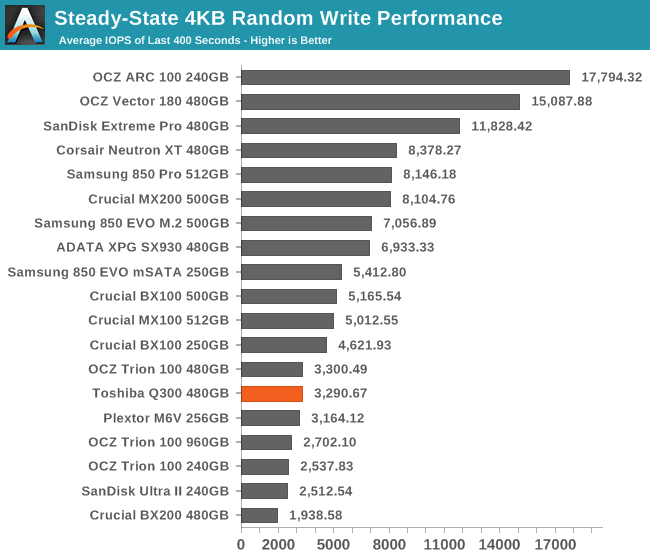
The Q300's steady-state performance is on par with the Trion 100: low, but well above the Crucial BX200 and SanDisk Ultra II. The latter drive uses SanDisk's second-generation 19nm TLC that is made on the same process as the flash in the Q300.

The write consistency of the Q300 is poor, but that's the case for most low-end drives - even the ones using MLC flash. As long as the performance has a reasonably high floor, a lot of variance is tolerable for client workloads. The Q300 is noticeably less consistent than the Trion 100.
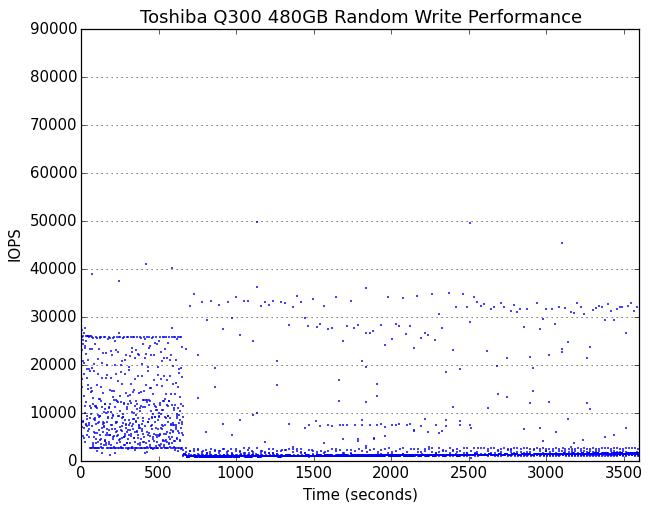 |
|||||||||
| Default | |||||||||
| 25% Over-Provisioning | |||||||||
It takes about ten minutes of full-speed writing for the Q300 to burn through its spare area, which is pretty good. The steady state that it reaches is mostly consistent save for some extreme outliers.
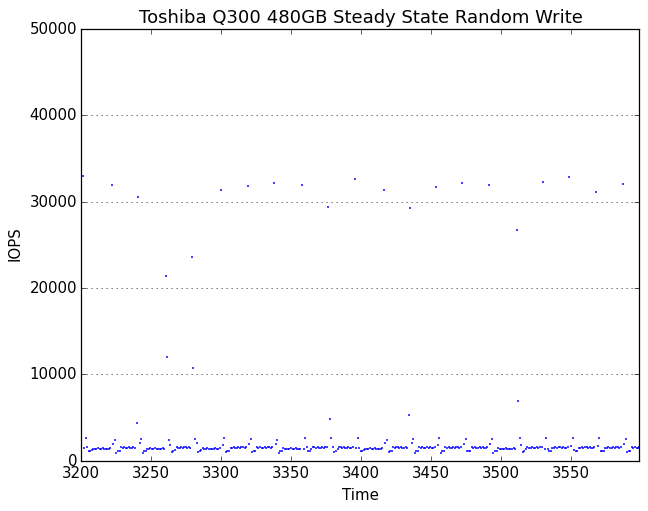 |
|||||||||
| Default | |||||||||
| 25% Over-Provisioning | |||||||||
The Q300's steady-state write performance is around 1500 IOPS with several brief excursions per minute up to 30k+ IOPS. With extra space reserved, the variance increases and the steady state ranges from about 1100 IOPS to about 5500 IOPS.
AnandTech Storage Bench - The Destroyer
The Destroyer is an extremely long test replicating the access patterns of very IO-intensive desktop usage. A detailed breakdown can be found in this article. Like real-world usage and unlike our Iometer tests, the drives do get the occasional break that allows for some background garbage collection and flushing caches, but those idle times are limited to 25ms so that it doesn't take all week to run the test.
We quantify performance on this test by reporting the drive's average data throughput, a few data points about its latency, and the total energy used by the drive over the course of the test.
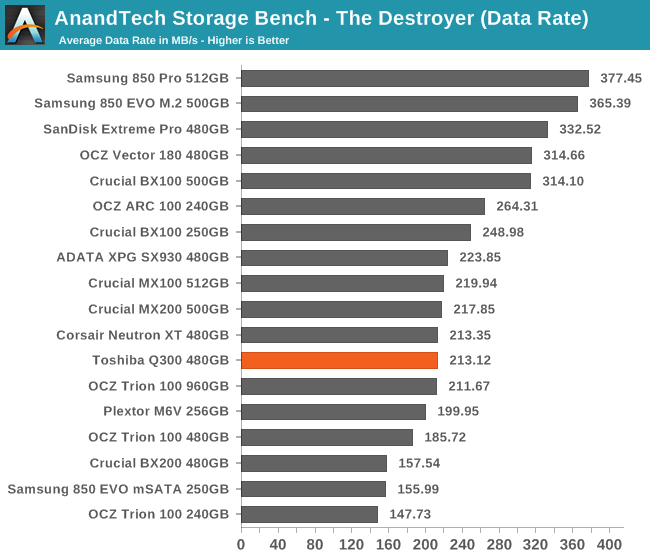
The Q300's average data rate during The Destroyer was slightly better than the Trion 100 480GB, and puts the Q300 around the middle of the pack and well ahead of the Crucial BX200. It's also slightly ahead of the Plextor M6V, a drive that uses MLC flash and prioritizes power efficiency over performance.
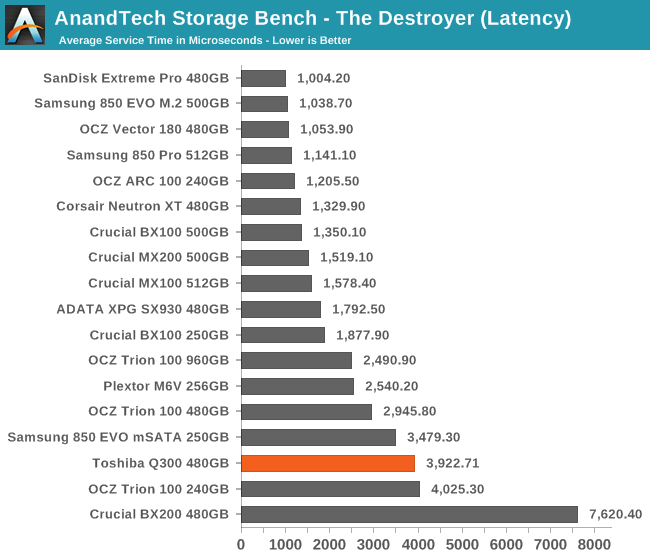
The average service time of the Q300 on The Destroyer is considerably worse than the Trion 100, and near the bottom of the chart. The performance consistency test showed the Q300 as significantly more variable than the Trion 100 before reaching steady state, so this result isn't inexplicable.
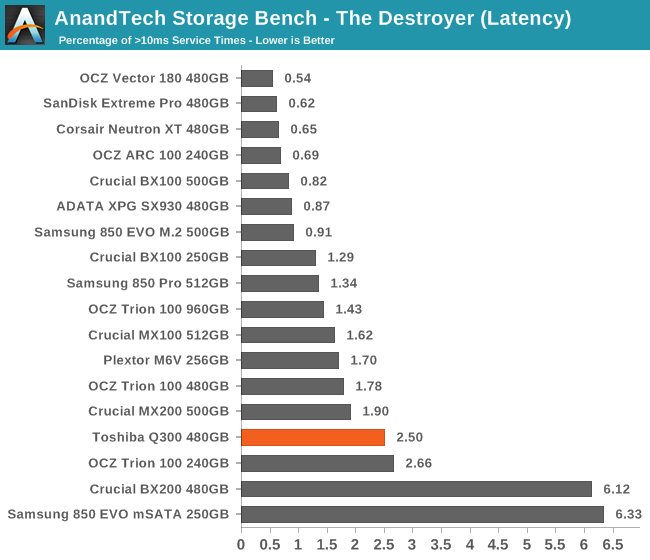
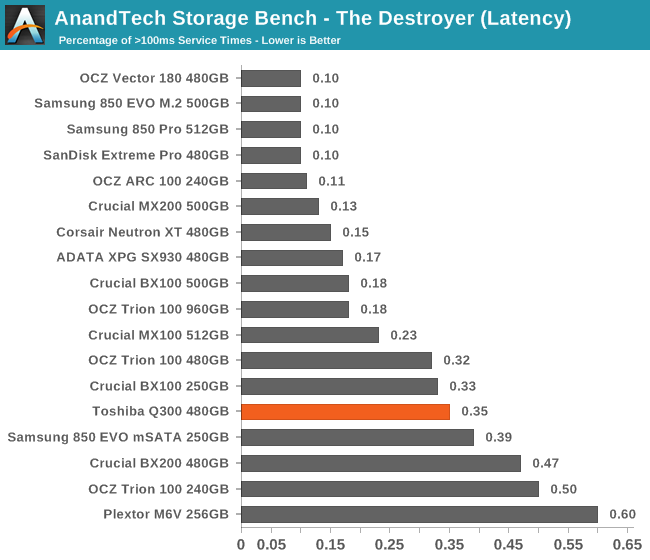
The Q300 has more severe latency outliers than the Trion 100, though neither drive is great at limiting latency.
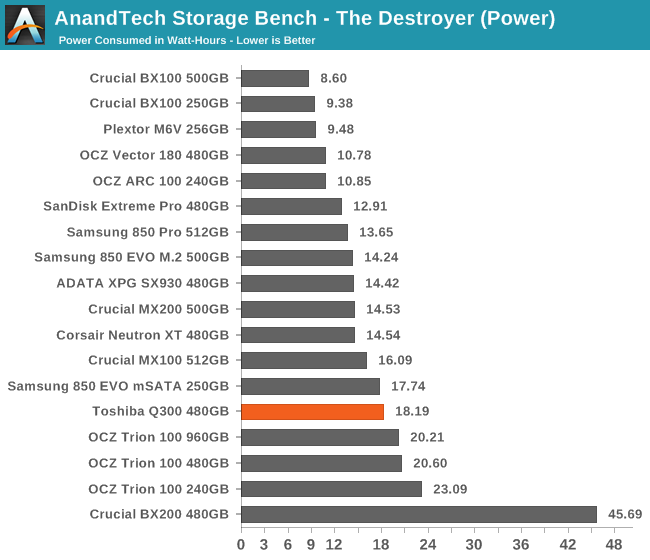
The Q300 shows improved power efficiency over the Trion 100, but the MLC drives are all better.
AnandTech Storage Bench - Heavy
Our Heavy storage benchmark is proportionally more write-heavy than The Destroyer, but much shorter overall. The total writes in the Heavy test aren't enough to fill the drive, so performance never drops down to steady state. This test is far more representative of a power user's day to day usage, and is heavily influenced by the drive's peak performance. The Heavy workload test details can be found here. This test is conducted twice, with the drive full and empty.
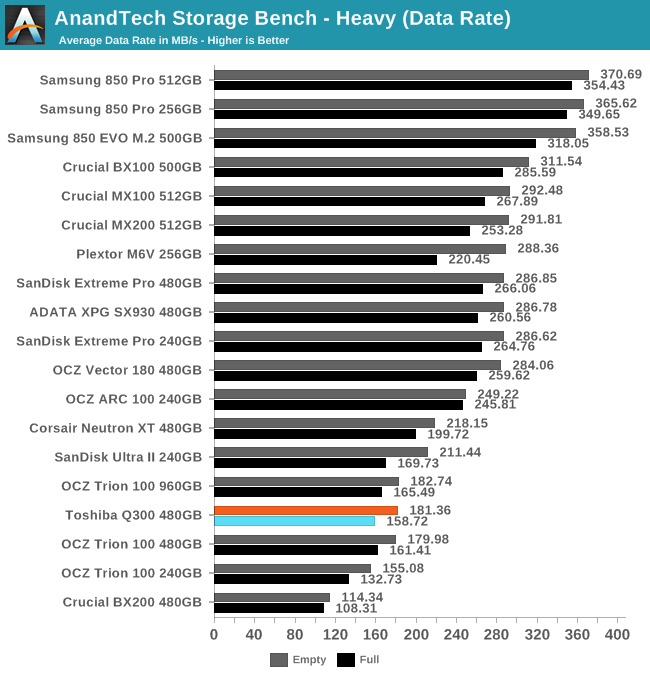
The Q300's average data rate on the ATSB Heavy test is the same as the Trion 100: low but not the worst we've seen, and about half what the Samsung 850 Pro delivers. All of the planar TLC drives perform worse than all of the MLC drives.
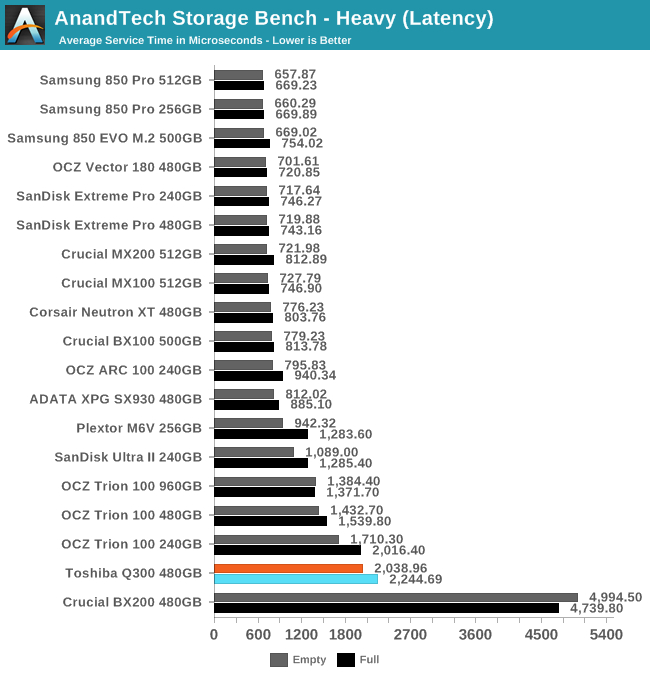
The Q300's average service time is again worse than the Trion 100, and is about twice that of the slowest MLC drive. The BX200 puts things in perspective: the Q300 is a disappointment, but isn't truly broken.
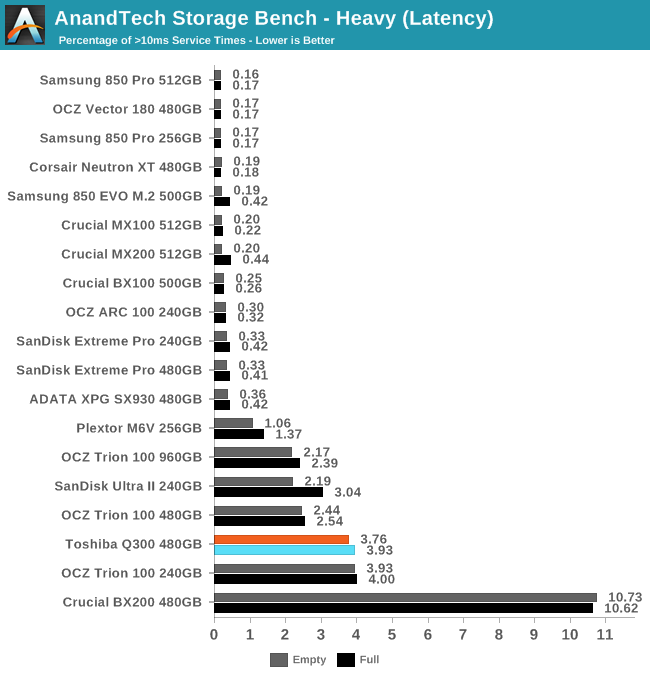
Most MLC drives are able to keep latency under 10ms almost all of the time, but the TLC drives get overwhelmed during the more intense parts of the test. The Q300 is worse than the Trion 100 480GB, but this time isn't worse than the smaller Trion 100.

The Q300 continues to be slightly more power efficient than the Trion 100, but the gap separating it from the MLC drives is quite clear. The SanDisk Ultra II managed to get much better efficiency out of nearly-identical TLC flash.
AnandTech Storage Bench - Light
Our Light storage test has relatively more sequential accesses and lower queue depths than The Destroyer or the Heavy test, and it's by far the shortest test overall. It's based largely on applications that aren't highly dependent on storage performance, so this is a test more of application launch times and file load times. This test can be seen as the sum of all the little delays in daily usage, but with the idle times trimmed to 25ms it takes less than half an hour to run. Details of the Light test can be found here.
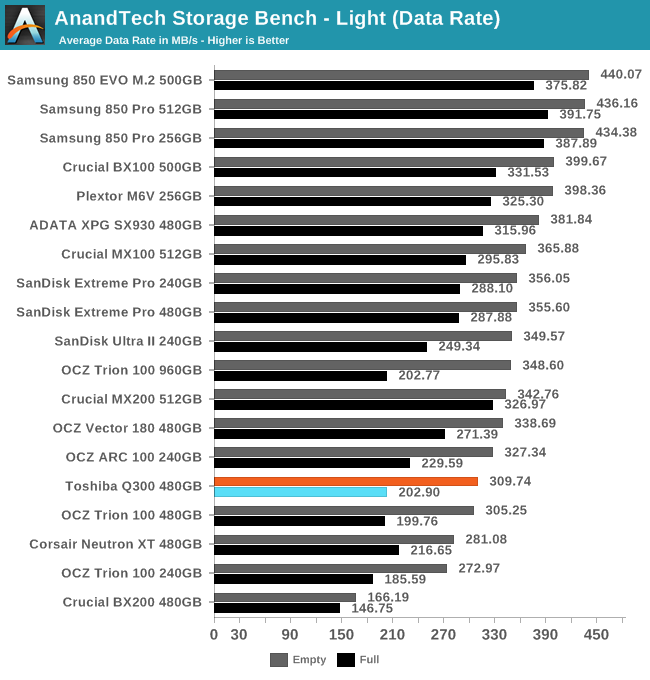
The performance rankings for the ATSB Light test are similar to the more intense tests, but the spread is much smaller and the difference between starting with an empty or full drive is much larger. A low-end MLC drive usually won't provide noticeably better performance than the Q300 on workloads this light.

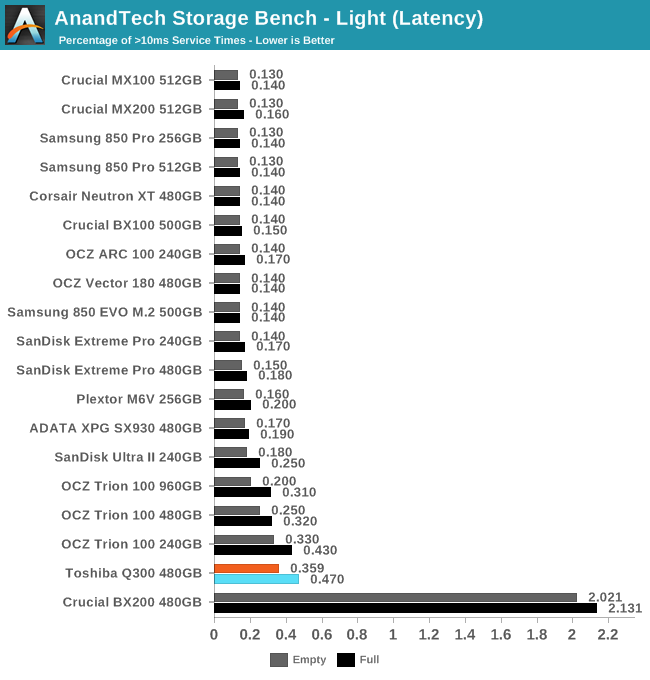
The latency of the Q300 is again near the bottom of the charts and worse than the Trion 100, but even for a full drive the average is only twice that of the best MLC SATA drives. The Q300 is underperforming for its capacity class, but is still reasonable for a SSD.
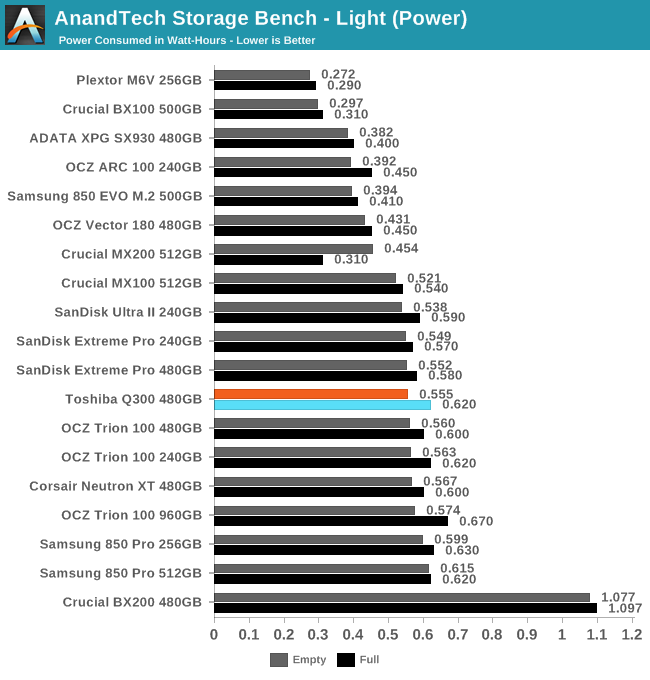
On light workloads like this, most drives don't stand out from the crowd in terms of energy efficiency. The top performers are mostly drawing proportionately more power and end up using the same amount of energy.
Random Read Performance
The random read test requests 4kB blocks and tests queue depths ranging from 1 to 32. The queue depth is doubled every three minutes, for a total test duration of 18 minutes. The test spans the entire drive, which is filled before the test starts. The primary score we report is an average of performances at queue depths 1, 2 and 4, as client usage typically consists mostly of low queue depth operations.
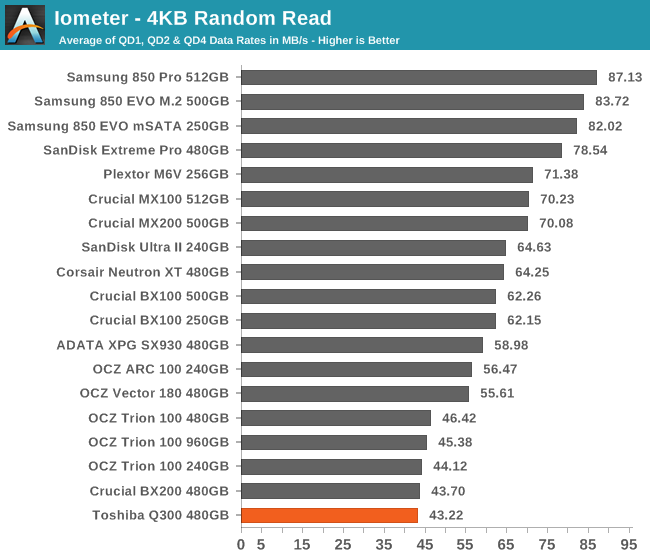
The Q300 performs only slightly worse than the Trion 100, but the difference is enough to push it below even the Crucial BX200 and into last place by a hair. The top-performing SATA drive by comparison, Samsung's 850 Pro, is twice as fast. The SanDisk Ultra II performs more like a MLC drive.
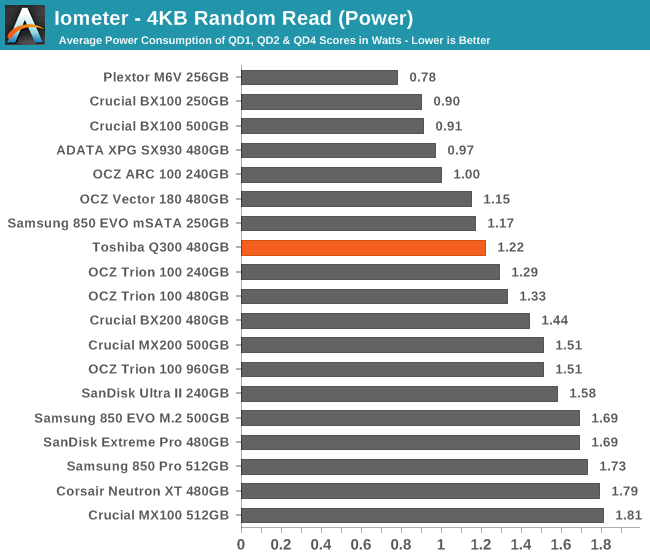
The Q300's power consumption isn't poor, but like most of the other TLC drives it's much less efficient than the typical MLC drive - let alone the SM2246EN-based BX100 and M6V.
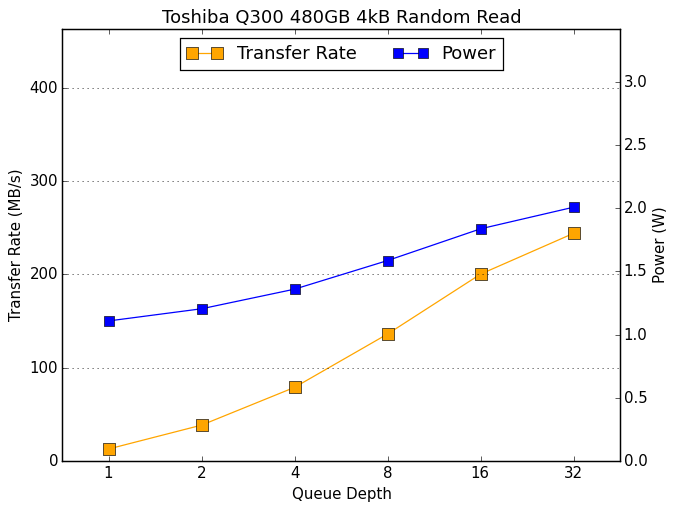 |
|||||||||
The Q300's random read performance scales with queue depth in a normal-looking manner, but the curve just isn't steep enough to compete.
Random Write Performance
The random write test writes 4kB blocks and tests queue depths ranging from 1 to 32. The queue depth is doubled every three minutes, for a total test duration of 18 minutes. The test is limited to a 16GB portion of the drive, and the drive is empty save for the 16GB test file. The primary score we report is an average of performances at queue depths 1, 2 and 4, as client usage typically consists mostly of low queue depth operations.

As with the random read test, the Q300, Trion 100, and BX200 are clustered at the bottom of the chart, demonstrating the they are not very good at mitigating the slower program times of TLC as compared to MLC flash. The SanDisk Ultra II seems to have much more effective SLC caching.
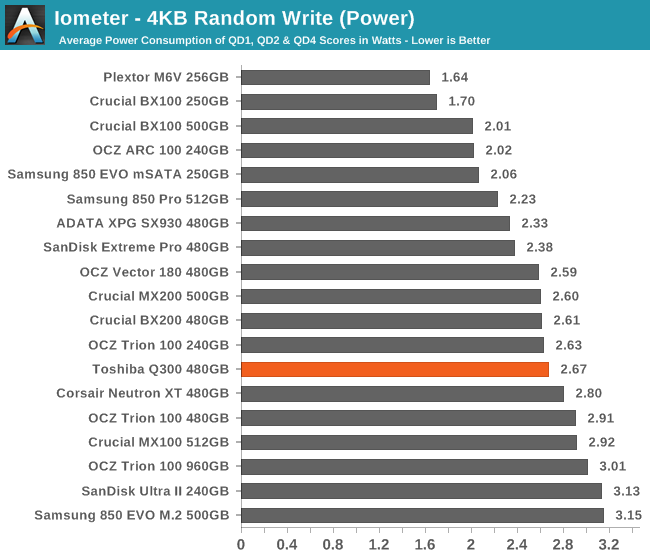
The Q300 was clearly a bit more efficient than the Trion 100 for random writes, but it doesn't put it anywhere near the efficiency of the drives that deliver solid performance.
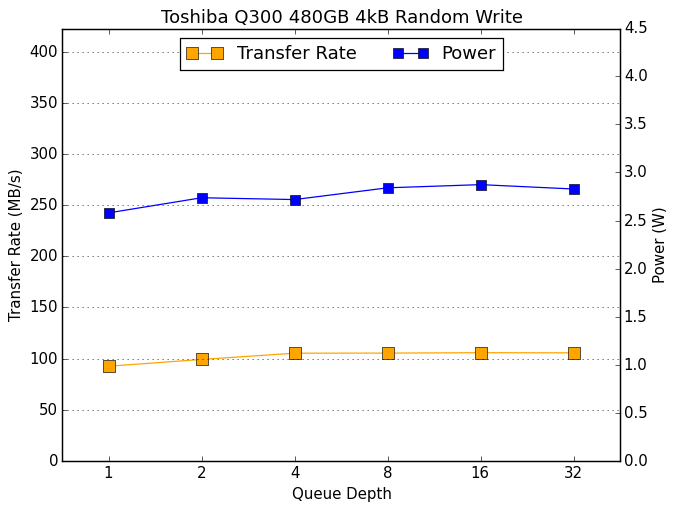 |
|||||||||
The Q300's random write performance scales very slightly as queue depth increases from one to four, and it stops there. The power consumption is lower than the Trion 100 at QD2 and higher. We've also seen this lack of scaling with the Crucial BX200, but the SanDisk Ultra II managed to use planar TLC flash without being similarly afflicted.
Sequential Read Performance
The sequential read test requests 128kB blocks and tests queue depths ranging from 1 to 32. The queue depth is doubled every three minutes, for a total test duration of 18 minutes. The test spans the entire drive, and the drive is filled before the test begins. The primary score we report is an average of performances at queue depths 1, 2 and 4, as client usage typically consists mostly of low queue depth operations.
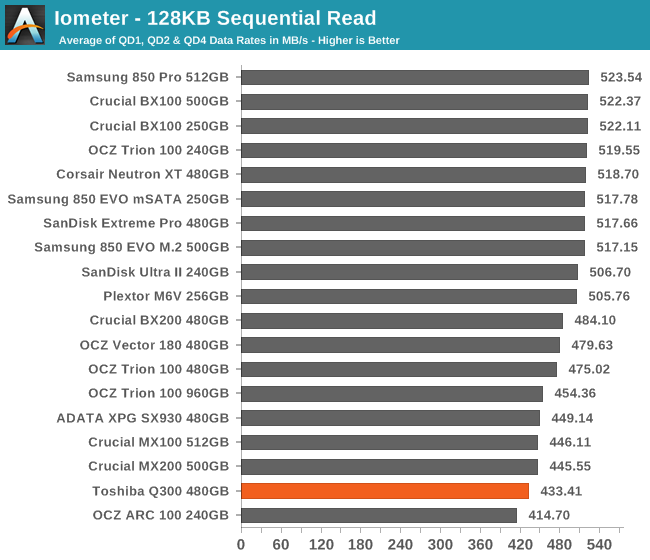
The Q300 shows a 9% performance drop relative to the 480GB Trion 100 on the sequential read test. It manages to stay out of last place, but it still disappoints and is clearly not bumping against the limits of the SATA interface at low queue depths.
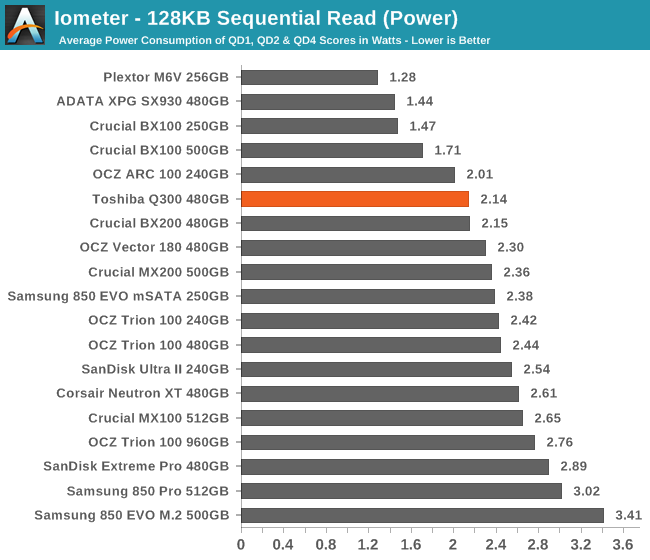
There's considerably more spread in power draw than performance on the sequential read test. The Q300's power consumption is good but not great, and most of the top performers sacrifice efficiency relative to the Q300.
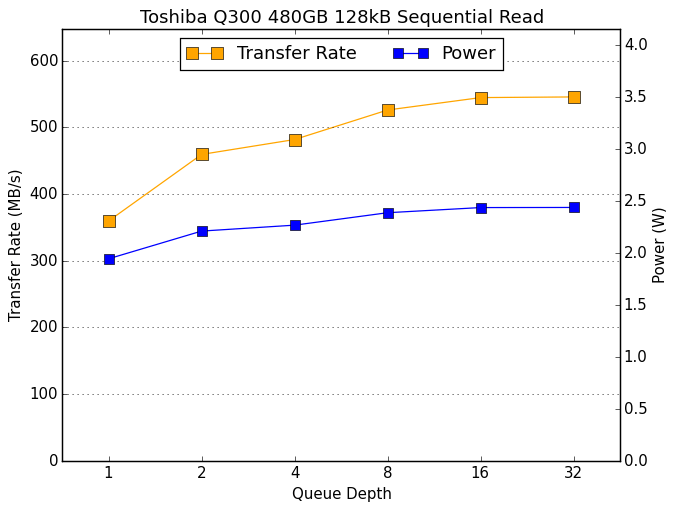 |
|||||||||
Like the larger capacities of the Trion 100, the Q300 doesn't reach full performance until QD16, and even then it's still about 10MB/s slower than the Trion 100 and closer to 20MB/s slower than the fastest SATA drives.
Sequential Write Performance
The sequential write test writes 128kB blocks and tests queue depths ranging from 1 to 32. The queue depth is doubled every three minutes, for a total test duration of 18 minutes. The test spans the entire drive, and the drive is filled before the test begins. The primary score we report is an average of performances at queue depths 1, 2 and 4, as client usage typically consists mostly of low queue depth operations.

Like the Trion 100, the Q300 does not perform well for sequential writes. The SanDisk Ultra II uses very similar flash, but its Marvell controller and different implementation of pseudo-SLC write caching manages much higher throughput.
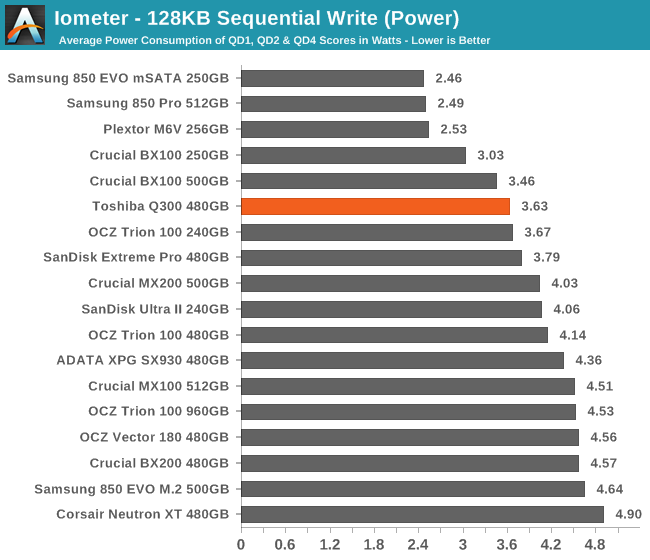
The Q300 is slightly more efficient than the Trion 100, but the planar TLC drives simply cannot hide the power cost of their longer flash program procedure.
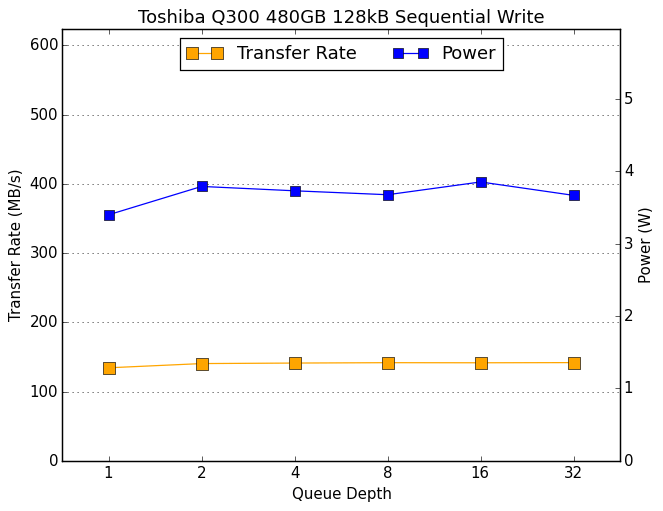 |
|||||||||
The Q300's sequential write performance is almost entirely unaffected by queue depth, and its power consumption varies only slightly. The top performers typically hit their limit once queue depth increases to two. When used with MLC flash in the Corsair Neutron XT, the Phison controller architecture was able to offer top-notch write speed that scaled with queue depth, but that was lost in adapting the firmware for use with TLC flash.
Mixed Random Read/Write Performance
The mixed random I/O benchmark starts with a pure read test and gradually increases the proprotion of writes, finishing with pure writes. The queue depth is 3 for the entire test and each subtest lasts for 3 minutes, for a total test duration of 18 minutes. As with the pure random write test, this test is restricted to a 16GB span of the drive, which is empty save for the 16GB test file.
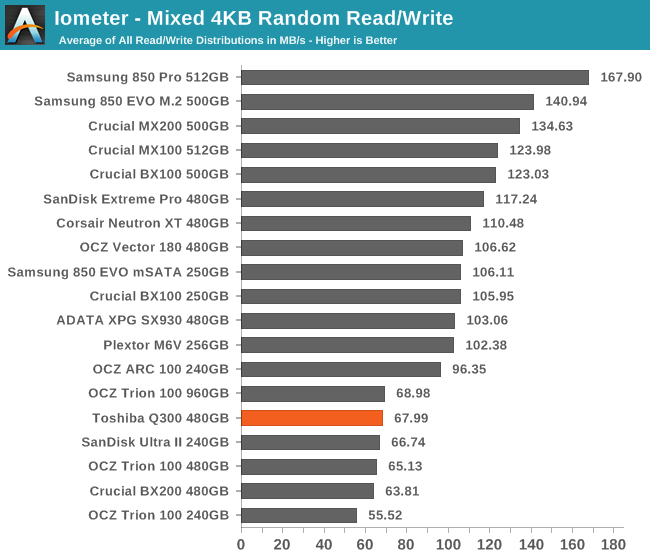
The planar TLC drives are clearly the bottom tier of mixed random performance, but the Q300's score is slightly above par by those standards. Despite using three different controller architectures, these drives all perform very similarly while the MLC drives have a fairly wide spread.
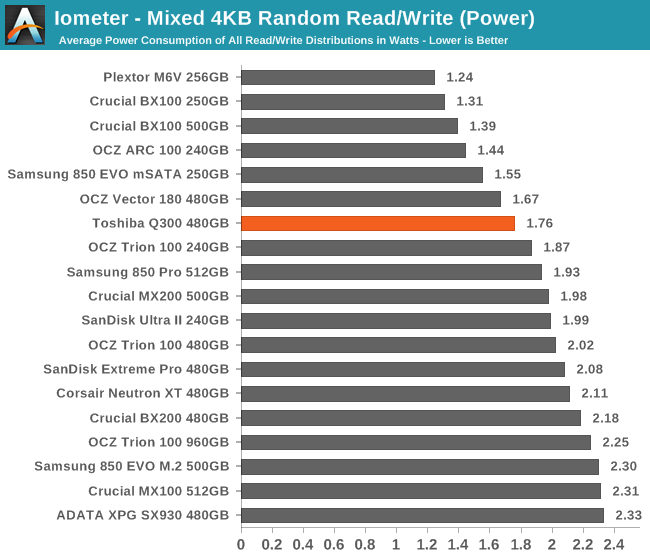
The Q300's power efficiency is significantly better than its planar TLC-based competitors and the power consumption in absolute terms is decent, but the MLC drives are mostly much more efficient due to much higher performance.
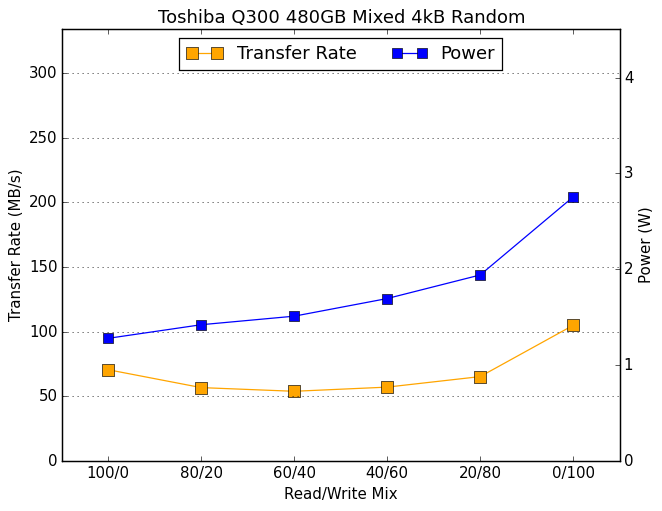 |
|||||||||
The slight drop in performance when writes are first added to the mix is not uncommon. What keeps the Q300's score low is that it does not exhibit large performance increases during the second half of the test, especially during the 100% write phase.
Mixed Sequential Read/Write Performance
The mixed sequential access test covers the entire span of the drive and uses a queue depth of one. It starts with a pure read test and gradually increases the proprotion of writes, finishing with pure writes. Each subtest lasts for 3 minutes, for a total test duration of 18 minutes. The drive is filled before the test starts.
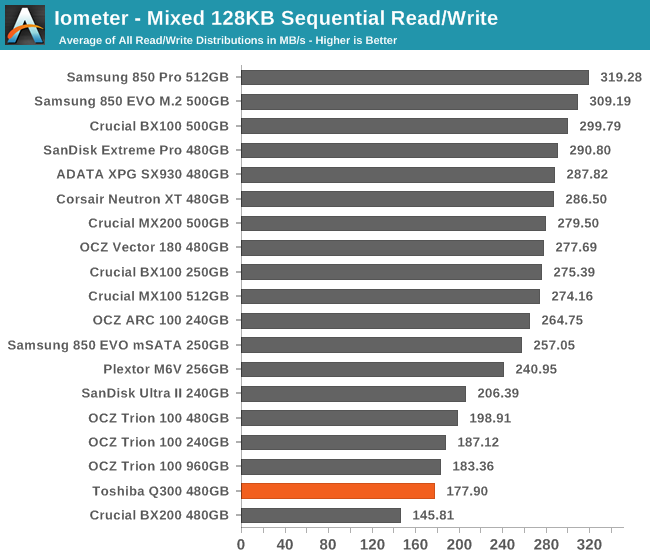
Unlike the random test, the Q300's performance on the mixed sequential test is clearly lower than the Trion 100, putting it in next to last place.
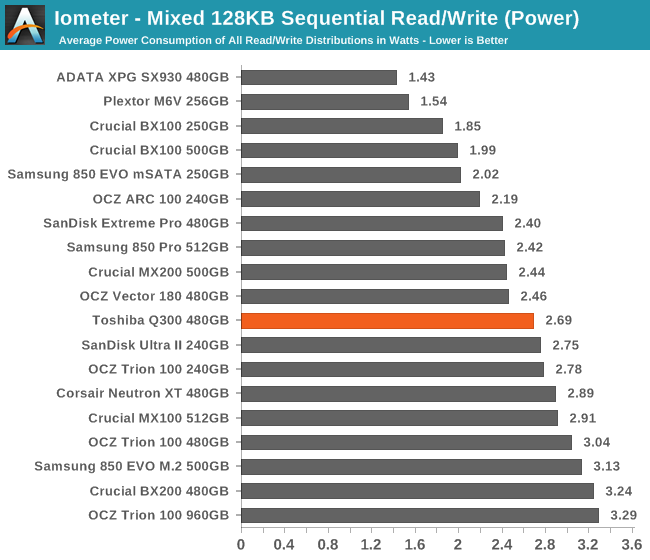
With middle of the road power consumption, the Q300's efficiency falls near the bottom, but the larger capacities of the Trion 100 and the Crucial BX200 are worse yet.
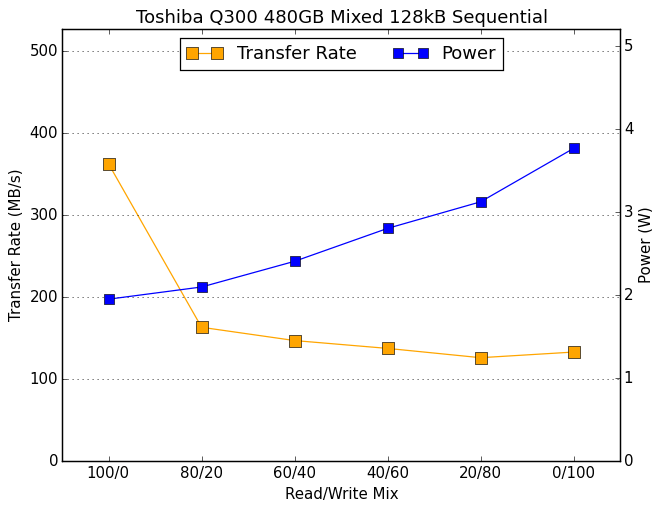 |
|||||||||
The Q300 isn't the only drive that doesn't recover performance at the end of the sequential test when the mix shifts toward pure writes. Its performance on the pure read phase at the beginning of the test is below almost every other drive except for the Crucial MX100 and MX200, which are redeemed by not dropping below 200MB/s in the later phases of the test. When writes are added to the mix, the Q300 drops to 163MB/s and keeps getting worse.
ATTO: Transfer Size vs. Performance
ATTO is a quick, easy and free tool to we use to test read and write speeds across a range of transfer sizes. This test is relatively short so it illustrates near-peak performance for a queue depth of 4.
The scaling of performance as transfer size increases looks normal, hitting a ceiling at 64kB and larger transfers, and with write throughput consistently a little bit slower than reading.
AS-SSD
AS-SSD is another quick and free benchmark tool. It uses incompressible data for all of its tests, making it an easy way to keep an eye on which drives are relying on transparent data compression.
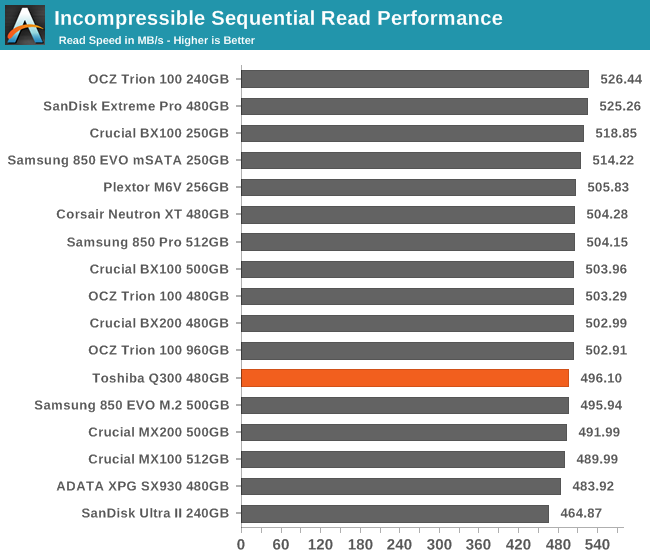
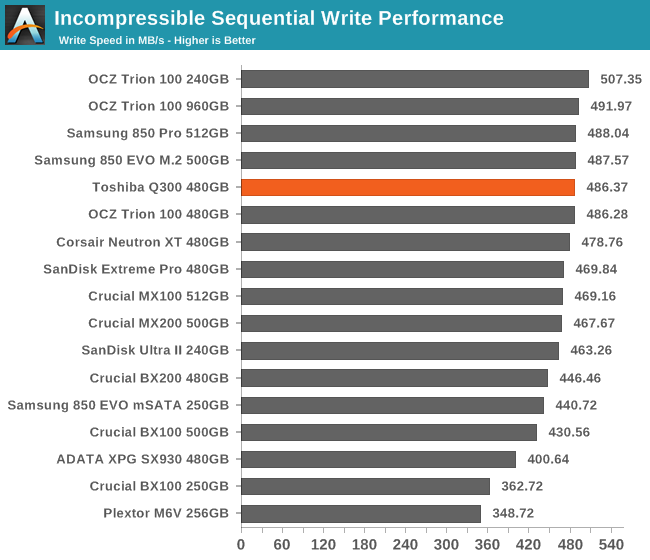
For the short duration of these tests, the Q300 delivers peak performance that doesn't stand out from the crowd, which is a good thing when most drives are bottlenecked by the SATA link speed.
Idle Power Consumption
Since the ATSB tests based on real-world usage cut idle times short to 25ms, their power consumption scores paint an inaccurate picture of the relative suitability of drives for mobile use. During real-world client use, a solid state drive will spend far more time idle than actively processing commands. Our testbed doesn't support the deepest DevSlp power saving mode that SATA drives can implement, but we can measure the power usage in the intermediate slumber state where both the host and device ends of the SATA link enter a low-power state and the drive is free to engage its internal power savings measures.
We also report the drive's idle power consumption while the SATA link is active and not in any power saving state. Drives are required to be able to wake from the slumber state in under 10 milliseconds, but that still leaves plenty of room for them to add latency to a burst of I/O. Because of this, many desktops default to either not using SATA Aggressive Link Power Management (ALPM) at all or to only enable it partially without making use of the device-initiated power management (DIPM) capability. Additionally, SATA Hot-Swap is incompatible with the use of DIPM, so our SSD testbed usually has DIPM turned off during performance testing.
Our SATA power measurements are conducted using a meter with a resolution of 1mA for the current on the 5V rail, giving our power consumption scores a resolution of 5mW. (The meter can offer microampere resolution for currents up to 400mA, but many drives would blow that fuse before the OS could put them to sleep.)

For mobile use, the Q300 falls in the second tier of drives that have acceptable but not great power consumption in the slumber state. Differences of a few tens of milliwatts won't have much impact on battery life for the kinds of devices that use 2.5" drives rather than M.2 or mSATA SSDs.
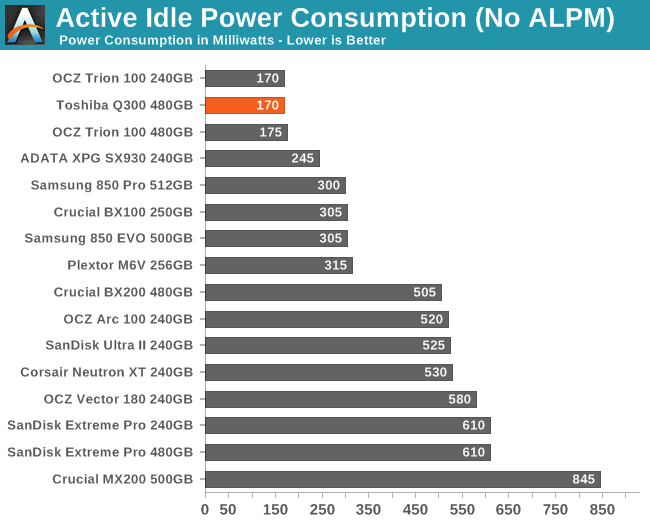
In a desktop situation with SATA ALPM disabled, the Q300 and Trion 100 offer the best idle power consumption. The other low-end TLC drives are drawing three times as much power.
Final Words
Given the strong hardware similarities to the OCZ Trion 100, I expected the Toshiba Q300 to turn in very similar benchmark scores. Instead, several noticeable differences cropped up: the Q300's latency is more variable, its active power consumption is a bit lower, and it completed The Destroyer a bit quicker. At least some of this (especially improved power efficiency) is probably due to the silicon lottery.
None of that is enough to have much effect on how it ranks. The Q300 is a low-end drive and is among the slowest SSDs on the market. It's hardly alone in that; I've lost count of how many different brands are selling Phison TLC drives. In that sense the Q300 doesn't stand out from that crowd, and while that doesn't make it a bad drive it means that Toshiba is entering a very competitive market with nothing substaintial besides their name to differentiate themselves.
With no clear price or performance advantage over even the OCZ Trion 100, the Q300 currently brings nothing new to the table. Its pricing has generally been at or above the Trion 100, so barring an unusual sale situation, there's little reason not to pick its OCZ doppelgänger. But considering the whole family of the Q300, Trion 100, and more related drives sold by other brands, the combination of Toshiba flash and Phison controller architecture has been successful at offering consumers a good budget option with no major weaknesses. Under light use, they're only slightly slower than MLC drives, rather than crippled as our most intense tests can make them look. Otherwise the SanDisk Ultra II is a better all-around performer, but at the moment only its 480GB capacity is in the lead for price.
| Value SSD Price Comparison | ||||
| Drive | 960GB | 480GB | 240GB | 120GB |
| Toshiba Q300 | $264.99 | $139.00 | $69.99 | $49.99 |
| OCZ Trion 100 | $199.99 | $129.99 | $64.98 | $54.99 |
| OCZ Trion 150 | $269.99 | $139.99 | $69.99 | $50.61 |
| ADATA SP550 | $219.99 | $119.99 | $61.99 | $39.99 |
| Crucial BX200 | $294.97 | $129.99 | $64.99 | |
| SanDisk Ultra II | $238.50 | $120.99 | $74.99 | $54.99 |
Ultimately Toshiba is in a unqiue position here that can work in their favor, even if starting things off with an entry-level drive doesn't allow them to take advantage of it. They are one of the major NAND flash manufacturers, and at the same time they have a special relationship with their controller vendor. Because of that they're not completely vertically integrated the way Samsung is, but they ought to be able to reap many of the same benefits in the long run.
From a product standpoint the Trion 100 did a good job of keeping pace with the price drops over the past several months, but neither it nor the new Q300 are sufficiently differentiated from the rest of the entry-level market. Now that Toshiba is directly participating in the retail SSD market with their own brand, I believe they should try for a unique blockbuster product to firmly establish their place. A big success like Crucial's MX100 or BX100 or Samsung's 850 Pro and EVO would make their retail venture worthwhile and could make either the OCZ or Toshiba brand a major name instead of another face in the crowd.

